
The second jewel in Paul’s Thessalonian Ring of Duties and Blessing is “Pray without ceasing.” This may be a taller order than the first duty of “rejoice always.” Does this literally mean that we should be praying all the time? How can a person do anything without stopping or pausing?
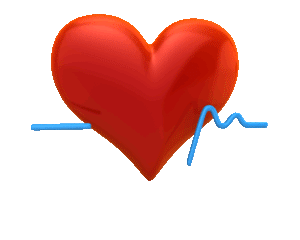
Is there anything that a normal person can do all the time? Are there things that humans do 24 hours a day, whether they are awake or not? Physiology and medical science tell us that human life is dependent upon the consistent functioning of certain organs.
The brain stems of living persons must be active all the time, controlling their automatic functions. Our hearts must constantly be pumping blood through our bodies. Our lungs must be inhaling and exhaling air all the time. We do these things at all times, “without thinking.” That’s why they are known as automatic functions.
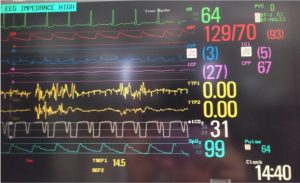
For much of medical history, the absence of activity in the heart and lungs was used to define death. Before medical monitors, people were declared dead if no heartbeat and breath were detected. With recent advances in medical science, hospitals are using machines “to keep people alive” by mechanically breathing and circulating blood for them. In these cases, doctors are resorting to the absence of brain waves to define death. If an electroencephalogram (EEG) monitor shows no brain activity for 30 minutes, we say the person has “flat-lined” and is clinically brain-dead.

Is Paul comparing praying to cardiac, pulmonary, and neurological activity? If a person demonstrates no joy, spends no time in prayer, or shows no spark of thankfulness, that person may be spiritually dead. The term “spiritually dead” is not used in the Bible. The closest reference I can find is found in Paul’s letter to the Ephesian church.
As for you, you were dead in your transgressions and sins, in which you used to live when you followed the ways of this world and of the ruler of the kingdom of the air, the spirit who is now at work in those who are disobedient. (Ephesians 2:1-2, NIV)
Although believers were physically alive before their conversion, they were in a state that Paul labels death. There is no activity in their spiritual life.
Thus, I believe Paul is indicating that prayer is a sign of spiritual life. As such, he is saying that it should be an automatic function in the lives of Christians. It should be our first response in all situations and circumstances. It is not meant to be a “fall back” or “last resort” action.
To understand what Paul is saying, it is helpful to go back to the scriptures’ words. Verse 17 of our text consists of two words in ancient Greek: ἀδιαλείπτως προσεύχεσθε. They would be typically transliterated into anglicized modern Greek as adialeiptōs proseuchesthe. What do these two words mean?

The word adialeiptōs can be used as either an adjective or adverb, meaning “unceasing, without stopping, without pause, incessantly.” It is a compound word, built from the two words, which individually mean “without” and “pause.” Since pause is usually considered a negative action, this combination is the Greek equivalent of a permissible double negative. It is a double negative, used to emphasize something positive.

The word adialeiptōs and its variations are used almost 40 times in the New Testament. The overwhelming majority of these instances concern prayer. This indicates that it is something to which we should pay special attention.
The word in verse 17 that is translated “pray” is also a compound word. The Greek word proseuchesthe is the combination of two words that carry the connotation of carrying on a conversation with God. It and its variations are used more than 90 times in the New Testament. This many references would indicate that it is definitely important. It would seem that the idea of praying without ceasing is an essential concept for Christians to grasp.
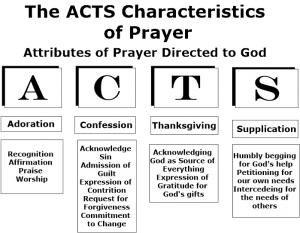
In scriptures and church tradition, there are generally four characteristics that should be part of the act of praying. A useful acronym to remember these characteristics is ACTS. The word stands for:
- Adoration The act of recognizing, affirming, praising, and worshipping God for who He is and what He has done.
- Confession The act of declaring, acknowledging, and admitting our sins and unworthiness in the face of God’s righteousness. It must include identifying one’s transgression, an admission of one’s guilt, an expression of one’s contrition, a request for forgiveness, and a commitment to forsake and refrain from that action in the future.
- Thanksgiving The act of acknowledging that everything we have comes from God and expressing gratitude for what God has given and done for us.
- Supplication The act of humbly requesting God’s help in meeting our own needs and desires (petition) and the needs and desires of others (intercession). The word supplication conveys the sense of humbly begging or pleading for something. We must approach God in abject humility.
In our prayers, we often combine one or more aspects into a single prayer. In fact, the prayer that Jesus taught his disciples as a model prayer combines three of the four characteristics.
Our Father which art in heaven, Hallowed be thy name. [Adoration] Thy kingdom come, Thy will be done in earth, as it is in heaven. [Supplication] Give us this day our daily bread. [Supplication] And forgive us our debts, as we forgive our debtors. [Confession] And lead us not into temptation, but deliver us from evil: [Supplication] For thine is the kingdom, and the power, and the glory, for ever. [Adoration] Amen.
One of God’s primary expectations for his children is that they depend only and always on Him. Part of that expectation is our duty to communicate with him in all circumstances and at all times.
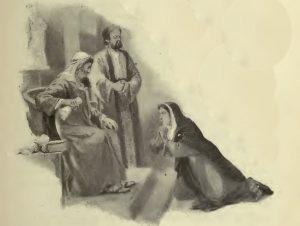
Prayer is our means of communicating with our heavenly Father. We must be in a constant attitude of prayer and dependence on God. Luke shares with us a parable that Jesus used to teach his disciples about prayer and dependence upon God. In chapter 18, we read.
One day Jesus told his disciples a story to show that they should always pray and never give up. “There was a judge in a certain city,” He said, “who neither feared God nor cared about people. A widow of that city came to him repeatedly, saying, ‘Give me justice in this dispute with my enemy.’ The judge ignored her for a while, but finally he said to himself, ‘I don’t fear God or care about people, but this woman is driving me crazy. I’m going to see that she gets justice, because she is wearing me out with her constant request!'”
Then the Lord said, “Learn a lesson from this unjust judge. Even he rendered a just decision in the end. So don’t you think God will surely give justice to His chosen people who cry out to Him day and night? Will He keep putting them off? I tell you, He will grant justice to them quickly! But when the Son of Man returns, how many will He find on the earth who have faith?” (Luke 18:1-8, NLT)
We are to pray in the morning:
In the morning, Lord, you hear my voice; in the morning I lay my requests before you and wait expectantly. (Psalm 5:3, NIV)
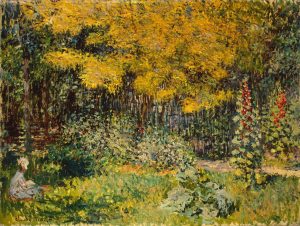
The French impressionist Claude Monet was not considered an overtly religious person. Few, if any of his works, involved subjects that would be considered particularly sacred. However, one in particular, his 1876 oil on canvas, Garden, reminds me of the well-known hymn by Charles Arthur Miles.
Communing in the morning with God was an essential part of the life of the gospel songwriter Charles Arthur Miles (1868-1946). Miles may be best remembered as the author and composer of the hymn In the Garden. The first verse and chorus illustrate the significance of morning prayers for him:
I come to the garden alone
While the dew is still on the roses
And the voice I hear
Falling on my ear
The Son of God disclosesAnd He walks with me
And He talks with me
And He tells me I am His own
And the joy we share
As we tarry there
None other has ever known
We are to pray in the evening:
I lie awake thinking of you, meditating on you through the night. (Psalm 63:6, NLT)

This Psalm was one of David’s wilderness Psalms. It was most likely written in Judah’s desert while he was fleeing Absolam. Absolam was David’s third son. He had an ingratiating personality and wove his way into a favorite spot in David’s heart. However, at the same time, Absolam was also overly ambitious and plotted with a group of disenchanted courtiers to depose and kill David. David had no choice but to flee Jerusalem. While in the wilderness, he sang Psalms as prayers of grief and suffering. Songs and prayers can be closely related.
Not everyone faces the difficulties David was facing. However, each of us has our own troubles. The sketch Old Man Praying by Vincent van Gogh reminds me of the second verse and the chorus of the praise song “Songs in the Night” by Matt Redman.
[Verse 2]
God, You can part the raging sea
Bring the miracle I need
Lord until it comes
I’ll wait here[Chorus]
And I will sing
Songs in the night
Praise in the storm
You’re God in it all
And I will stand
I’ll be still and know
Whatever may come
You’re God in it all
We are to pray in the midday:
Evening, and morning, and at noon, will I pray, and cry aloud: and he shall hear my voice. (Psalm 55:17, KJV)
In this verse, God, speaking through David, teaches us several things about prayer. The verse begins by suggesting that David was praying throughout the whole day. In our reckoning, we would have probably said, “Morning, noon and night.” Why did David start with the evening?
In Jewish tradition, sunset is the transition from one day to the next. Thus the evening is the beginning of a new day. While midday, or our noon, was the middle of the “working day,” for the Jews of David’s time, it was a time of respite. It was the “hump” part of the working day. It was time to take a short rest, eat a bite of food, and spend a little time in prayer. It signified that the day was rapidly winding down to its conclusion.

One of the most recognized noon-time prayers is Peter’s prayer in Acts 10.
About noon the following day as they were on their journey and approaching the city, Peter went up on the roof to pray. He became hungry and wanted something to eat, and while the meal was being prepared, he fell into a trance. He saw heaven opened and something like a large sheet being let down to earth by its four corners. It contained all kinds of four-footed animals, as well as reptiles and birds. Then a voice told him, “Get up, Peter. Kill and eat.” [Acts 10:9-13, NIV]
Peter’s prayer, vision, and response changed the face of Christianity and missions. As a result of the vision, Peter received the centurion Cornelius’s servants, a righteous and God-fearing man. He listened to their story and accepted their invitation to meet with their commander.
In the subsequent visit with Cornelius and a large gathering of Gentiles, Peter preached the gospel message. Many were convicted, saved, and baptized. Salvation was no longer restricted to Jews. It was open to everyone.

One can not talk about prayer without including the example of Jesus in Gethsemane. Since prayer is the personal act of communicating with God, it can be a joyous or agonizing event. Jesus spent an agonizing night, praying in the Garden of Gethsemane. He knew what was coming and asking God “to remove this cup from me.” However, He also knew that His crucifixion was a necessary part of God’s plan of salvation. Thus, He yielded His human desires to God’s perfect will.
Jesus’ prayer is recorded in John 17. Father, the hour has come. Glorify your Son, that your Son may glorify you. For you granted him authority over all people that he might give eternal life to all those you have given him. Now this is eternal life: that they know you, the only true God, and Jesus Christ, whom you have sent. [John 17:1-3, NIV]
After praying for Himself, Jesus continued by praying for His disciples and then all believers. After He finished praying, He was arrested.
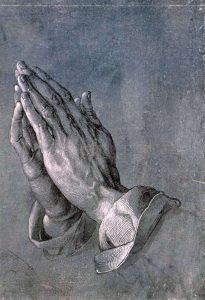
I can’t speak of prayer without remembering Albrecht Dürer’s iconic image of prayer. This early 16th-century pen and ink drawing on blue paper that Dürer made himself is known as either “A Study of the Apostle’s Hands” or simply “The Praying Hands.“
This image has been copied and reprinted millions of times. It has been made into jewelry, statuettes, bookends, and paperweights. It has adorned thousands of walls, desks, bookshelves, and altars. It has called millions of people to prayer. Let it call you to prayer. Amen.
Leave a Reply